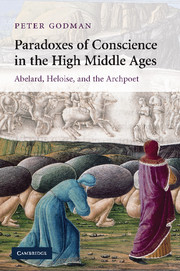Book contents
- Frontmatter
- Contents
- Preface and acknowledgements
- List of abbreviations
- 1 Moral moments
- 2 The neurotic and the penitent
- 3 True, false, and feigned penance
- 4 Fame without conscience
- 5 Cain and conscience
- 6 Feminine paradoxes
- 7 Sincere hypocrisy
- 8 The poetical conscience
- Envoi: Spiritual sophistry
- Bibliography
- Index of quotations
- General index
- CAMBRIDGE STUDIES IN MEDIEVAL LITERATURE
3 - True, false, and feigned penance
Published online by Cambridge University Press: 30 September 2009
- Frontmatter
- Contents
- Preface and acknowledgements
- List of abbreviations
- 1 Moral moments
- 2 The neurotic and the penitent
- 3 True, false, and feigned penance
- 4 Fame without conscience
- 5 Cain and conscience
- 6 Feminine paradoxes
- 7 Sincere hypocrisy
- 8 The poetical conscience
- Envoi: Spiritual sophistry
- Bibliography
- Index of quotations
- General index
- CAMBRIDGE STUDIES IN MEDIEVAL LITERATURE
Summary
Two, not three, types of penance exercised the moral imagination of the early Middle Ages. For feigning in this context there was, or ought to have been, no place. Truth versus falsehood, white against black, with scarcely a hue of ethical indeterminacy between them: such were the categories in which the penitential ‘tarifs’ were computed. Dispensed from burdening their brains with vexing questions of personal responsibility, sinners fasted, paid fines, and abstained from sex. Sex representing the major exception to these rules of literalism, fictio was suspected in the limited form of reticence. It was overcome by confessors in ever longer lists of questions that anticipated what partial penitents might be unwilling to admit. Failure to respond or to accept the sanctions imposed was taken to demonstrate falsehood. So too was an ingenious resort of embarrassment, cunning, or subterfuge: dividing up one's accumulated transgressions, and confessing some to one priest and others to another. for the Church, this amounted to the dirt of disavowal.
That dirt could be cleansed only by unabridged candour. Official pronouncements on the subject remained within the confines of the black-and-white mentality well into the second quarter of the twelfth century. ‘True and false penance’, for example, was dealt with at the second Lateran Council which opened, on 3 April 1139, with a speech by Innocent II, now uncontested as pope after the death of his rival Anacletus II and the resignation of Victor IV. The tone was upbeat.
- Type
- Chapter
- Information
- Paradoxes of Conscience in the High Middle AgesAbelard, Heloise and the Archpoet, pp. 44 - 65Publisher: Cambridge University PressPrint publication year: 2009



